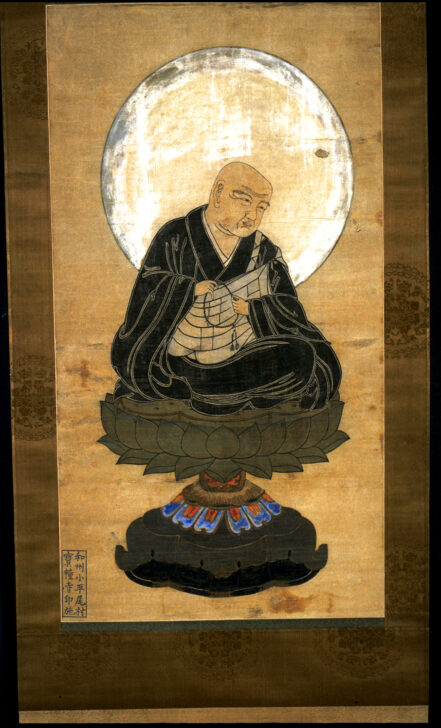Portrait of a Monk (Hônen?): Pilgrimage Souvenir from Hôshôji, Kodairao ?) Village, Wakayama Prefecture
Japanese

Description
Pilgrimage Souvenir with the Portrait of Hōnen:
Japan
Edo Period (1615-1868)
19th century
Hand-colored woodblock print on paper mounted as a hanging scroll
Museum Purchase for the Paul Leroy Grigaut Memorial Collection, 1971/2.11
Like the triptych of Zen patriarchs also on display in the gallery, images of patriarchs of other
schools of Buddhism were produced, although in this instance, this portrait of the monk Hōnen
(1133-1212) was likely one of many affordable images made for pilgrims. The construction of
major toll-roads during the Edo period (1615-1868) provided a new opportunity for ordinary
people to travel, albeit with government-issued travel passes. As pilgrimages were an
acceptable reason to travel, interest in visiting sacred sites increased. Hōnen (1133-1212) rose
to prominence due to his belief that Buddhist salvation was possible through simply reciting the
nenbutsu, a short phrase dedicating oneself to Amida, the Buddha of the Western Paradise.
This drastic simplification of Buddhist belief allowed for the lower classes to convert to
Buddhism, allowing Hōnen to gain a significant following. This angered elite Buddhist institutions
with close ties to the aristocratic court, leading Hōnen to be exiled. However, this had little effect
on Hōnen’s popularity, and he eventually founded Pure Land Buddhism, a sect of Buddhism
that remains popular to this day.
Subject Matter:
This portrait of a monk appears to be Hōnen, based on his usual iconography in portraits. He is usually depicted wearing black monk's robes and holding a rosary, and can be identified by the flattened crown of his head, seen in this image. Hōnen (1133-1212) established the Pure Land sect of Buddhism in Japan during the early Kamakura period (1185-1333 ), and gained immense popularity. Portraits of Hōnen were produced from soon after his death in the early thirteenth century, and his image was included in group portraits of the patriarchs of the Pure Land sect. Based on the inscription in the bottom left corner of this image, this portrait was produced at Hōdō- ji , in Kobiraomura in Yamato Province (present-day Nara Prefecture).
Physical Description:
This hanging scroll shows a monk seated cross-legged on a lotus pedestal with his head and shoulders surrounded by a white halo. He is dressed in black robes, with a white, geometrically patterened kesa. He holds a Buddhist rosary in both hands, and looks downwards into the distance.
Usage Rights:
If you are interested in using an image for a publication, please visit https://umma.umich.edu/request-image/ for more information and to fill out the online Image Rights and Reproductions Request Form.